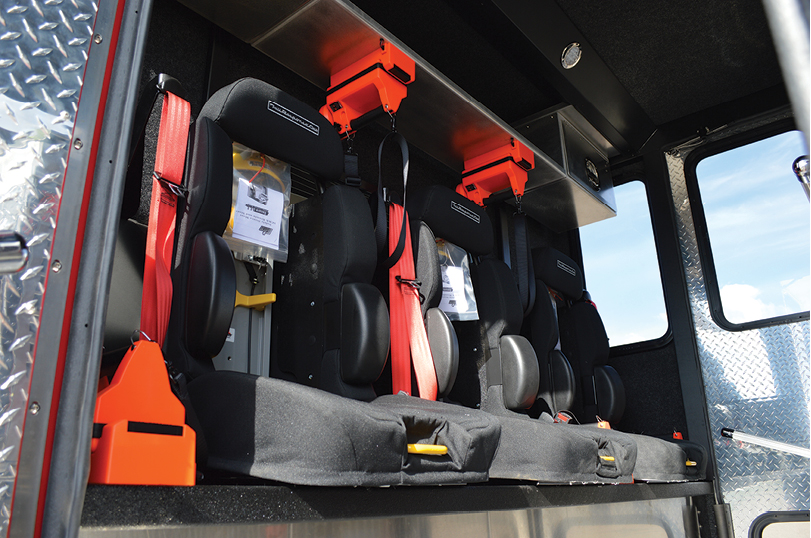
Keeping It Safe Robert Tutterow
WARNING! Reading this column could result in anxiety, accelerated heart rate, high blood pressure, and profanity.

I recently attended a trade show and was admiring a very expensive well-thought-out pumper. This rig was also very expensive, and it would be easy to tell the dealer to keep the change if you gave it a $1 million bill to pay for it. One of the features of the rig was a self-contained breathing apparatus (SCBA) storage compartment right behind the cab. The seats within the cab were not designed to store the SCBA. And, this is where the story begins.
I was told the department’s safety officer was responsible for the part of the specifications that required that the SCBA not be in the cab. However, the safety officer was retiring shortly before the new apparatus was to be delivered. The new safety officer convinced the fire chief that the SCBA must be stored in the cab. As a result, the fire department ordered new seats (designed to hold SCBA) for the rig. The new seats were to be installed before the pumper went into service.
The safety aspect of the SCBA being stored in the cab can become an emotional argument that is somewhat lacking in merit. The clear argument for them to be in the cab centers around deployment times and readiness to immediately fight fire upon exiting the cab. Therefore, donning the SCBA after exiting the cab delays fire suppression tasks. Let’s take a closer look.
First, what is the sequence of donning the SCBA while in the cab and buckling the seat belts? Securing the seat belts seems to be a task that is done after the SCBA straps are secure. The SCBA straps do not need to be on top of the seat restraint straps. With that being the case, how often does the driver delay moving the vehicle until the SCBA straps and the seat belt straps are secure? Isn’t this also delaying suppression tactics? Unfortunately, there are too many cases where the driver does not wait, and the crew ends up responding to the fire, or at least partially to the fire, without being properly belted. This is totally unacceptable and indefensible. And if an SCBA seat is unoccupied, what are the chances that SCBA is positively secured in the seat back? There is a reason the National Fire Protection Association requires that firefighter helmets be positively secured in the cab during response. A loose helmet can be lethal in a crash. What about a loose SCBA? Yes, wearing a structural helmet while responding is not safe. They are not crash helmets, and the weight of the helmet can cause additional injury because of the added weight on the head during an impact.
The issue of a clean cab—no, it is not a concept, it is a practice for fire departments that value their members’ health—cannot be ignored in this discussion. It is known that cleaning SCBA is one of the most difficult, if not the most difficult, of all personal protective equipment (PPE) elements and other firefighting equipment to clean following a fire. Preliminary exposure reduction on the scene is not as effective with SCBA as it is with the rest of the PPE ensemble. For proper cleaning, the unit must be doffed and washed in a machine designed to wash SCBA or handwashed.
Then there is the issue of exiting the cab while wearing an SCBA. A firefighter’s stability is not as good when exiting the cab if he is wearing the SCBA. This is a situation that rarely receives attention as cab exit is treacherous, especially at night, and the surface for the foot landing can easily be less than that of a smooth apparatus bay floor. For example, broken pavement, storm drains, and utility access covers can all be hazardous.
Clearly, these “arguments” can easily fall on deaf ears. But there is one compelling argument that is not based on the “ifs”: There are a couple of large major metro fire departments that took the SCBA out of their cabs well over 20 years ago. There has been no negative impact on their service delivery, and I have been told that there would be outrage by the firefighters if the SCBA had to go back in the cabs. The firefighters find the seats far more comfortable without an SCBA bracket in the seat back.
There is one advantage to having the SCBA in the cab: It requires less compartment space. However, the American fire service has gotten a lot smarter in organizing its compartments, and there are creative ways to minimize the negative impact of the loss of compartment space.
What would a risk management assessment reveal about SCBA in the cab?
ROBERT TUTTEROW retired as safety coordinator for the Charlotte (NC) Fire Department and is a member of the Fire Apparatus & Emergency Equipment Editorial Advisory Board. His 44-year career includes 10 as a volunteer. He has been very active in the National Fire Protection Association through service on the Fire Service Section Executive Board and technical committees involved with safety, apparatus, and personal protective equipment. He is a founding member and president of the Fire Industry Education Resource Organization (F.I.E.R.O.).

